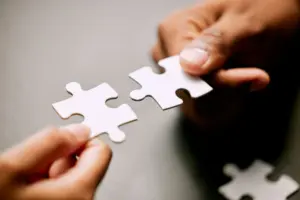Is Sound Masking Technology Worth the Cost?
If not the number one complaint in the office, noise distractions are certainly in the top five reasons office occupants struggle to be productive. Indirect conversations overheard by an unintended listener distracts that individual from doing their independent work. It’s annoying and decreases productivity. But what can be done about those conversations?
Common Solutions for Excess Noise Distractions
To understand the solutions for controlling excess noise we look at the key principles, or ABCs, of noise control.
- Absorb (A)
- Noise travels in a wave and looks for the path of least resistance. Soft, absorptive materials mitigate the noise by reducing its path and keeping it from reverberating off of surfaces.
- Block (B)
- Blocking the path of a sound wave is accomplished by using hard surfaces such as drywall, glass or concrete to reflect the noise back into the space and keeping it from traveling into other areas.
- Cover (C)
- Covering, or masking, sound is accomplished by introducing additional noise into the space at a level above the indirect sound level. This effect minimizes the intelligibility of the noise and reduces the distraction it would otherwise create.
One solution for controlling unwanted noise distractions is the use of fabric panels. Fabric panels, covering entire walls or acting as accents, were all the rage in the eighties and early nineties. You would also see fabric panels used in partition systems (i.e., cubicles). But as design trends changed due to better understanding of space utilization and function, fabric panels soon found themselves left off of the space specification. Fabric technology has come a long way since the nineties panels and, once again, have found themselves as a part of space design, albeit in a more limited capacity. These soft, absorptive, unique products do serve a role in controlling sound within a space.
Another solution is the growing popularity of the “phone booth” concept. More commonly referred to as “huddle rooms” or “meeting pods”, these pre-built, unique spaces allow one to four people, typically, to assemble in a conference room environment. These pods contain and control the private conversations as a space within the space. They offer the comforts of controlling sound within the space so unintended listeners outside do not overhear the conversation and are allowed to continue their work. Unfortunately, this solution isn’t typically practical for most office environments from both a design and a cost perspective.
A third solution is the use of “white noise solutions” to minimize distraction and increase productivity. The benefits of white noise machines, properly referred to as sound masking solutions, is to introduce a gentle, non-invasive sound just above the level of indirect speech. The intention is to cover or mask the conversation and render it unintelligible. The unintended listener will know there is activity around them but because they cannot understand the conversation they will not be distracted by it. Because sound masking can be implemented relatively inexpensively, it is one of the better return on investments, specifically in evaluating the noise control space.
What Does Sound Masking Technology Do?
Sound masking is not a cone of silence. It is the introduction of background sound into a space to make it “feel” quieter, more comfortable and minimize distraction. It is a strange concept that the introduction of more background noise would make a space “quieter.” But it works and here is why.
The average individual speaks at 65 decibels (dB). As you begin to move away from the source the speech level gets quieter. Around 12 feet from the source, we will now refer to this as indirect speech, the decibel level drops to 46 dB. Sound masking systems introduce sound into the space at a level just above that indirect speech level, at 47-48 decibels. The sound masking technology is covering the indirect speech with a gentle, comfortable sound that is louder than the indirect speech. It is simply a signal to noise ratio.
What Value Does Masking sounds Provide?
The true value of a sound masking system is productivity. Sound masking systems deliver speech privacy, minimize distraction, and deliver comfort. All of this results in employee productivity and satisfaction.
Protect Speech Privacy
As described above, a sound masking system delivers a sound level just above indirect speech levels to reduce the amount of conversation that can be overheard by an unintentional listener. This is speech privacy for those having the conversation. Sound masking protects their speech by making it unintelligible.
Boost Overall Productivity
By protecting speech privacy, sound masking systems also reduce the amount of distraction for the unintended listener. This secondary effect improves productivity for that individual because they are not pulled away from their efforts. Studies show that for every workplace distraction it can take an average of 25 minutes to return to normal production levels. Therefore, minimizes the amount of distraction is imperative to worker productivity.
Raise Employee Satisfaction
Who doesn’t want to enjoy the environment you work at? Not only do sound masking systems provide speech privacy and productivity, but with the right sound, sound masking can improve the comfort of the space. A employee will achieve a higher level of satisfaction if their environment “feels” comfortable.
How Much Does a System to Mask Sounds Cost?
A new sound masking system can cost anywhere from $ 2.00 to $ 2.75 per square foot fully installed. There are a lot of factors that impact the cost such as the type of system installed and the timing of the installation. New construction with a networked, in-plenum system installed prior to the acoustical ceiling going in is less expensive than a retrofit, direct fired system done on a weekend, for instance. However, when ballparking it, sound masking systems cost around $ 2.50 installed. Half of that cost tends to be equipment with the other half being labor, give or take a few percentage points.
Is Sound Masking Worth the Cost?
Offices, or any space for that matter, are designed to maximize the footprint of the space for employee productivity. This is how the occupant realizes a return on the property and employee investment. The value sound masking provides is the opportunity to maximize the output of the employee by minimizing the distractions and creating a more comfortable environment. Without sound masking building occupants run the risk of overhearing unintentional conversations which can be distracting and take them off task. Furthermore, given the design elements of spaces today, with very little control of noise, reverberation of sound can make a space noisy.
Sound Masking is a relatively inexpensive way to help maximize productivity of employees and improve overall satisfaction through a more comfortable space. Here is a quick way to calculate the Return on Investment of a sound masking solution. And, if you would like to read more, here is an ROI blog post.
How Can Lencore Optimize Your Office Acoustics and Improve Productivity?
Sound masking is the introduction of noise into a space in order to make it more productive by reducing the amount of distractions. Lencore sound masking systems produce a comfortable noise, blending white and pink noise frequencies, into the space at a level slightly above indirect speech levels (around 47-48 decibels.) This solution minimizes the level of distraction caused by the collaborative discussion occurring 10-12 feet away. Sound masking reduces the percentage of the conversation that the unintended listener(s) can understand and allows them to focus on their independent work – making them more productive.
Furthermore, Lencore office sound masking solutions produce a comfortable environment. Because of the tailored frequencies within the sound, the office space “feels” more pleasant and easy to work within. Lencore has installed sound masking systems in open offices, call centers, and law offices for thousands of companies to cover, or mask, speech and deliver a more productive, comfortable environment. See our open office applications and case studies.
Learn more about Lencore.
Check Out Our Other Articles Below:

The Science of Habituation and Office Noise Reduction Through Sound Masking
In the modern workplace, distractions are everywhere: conversations across the hall, the ping of a notification, and the hum of HVAC systems. This noise in the workplace contributes to constant interruptions and environmental stressors. But beyond irritation,

Maximize Your Investment: Integrate Paging into Your Sound Masking System
When a client starts planning for a sound masking system, they are usually focused on reducing distractions and improving speech privacy. But if you are already investing in a system that reaches every corner of your space,

Master Certified Installer Spotlight: Sean McGrath of Birkstone Services
When it comes to creating comfortable, private, and productive workspaces, sound masking has become a crucial part of modern building design. Few understand this better than Sean McGrath, owner of Birkstone Services, a structured cabling company with
